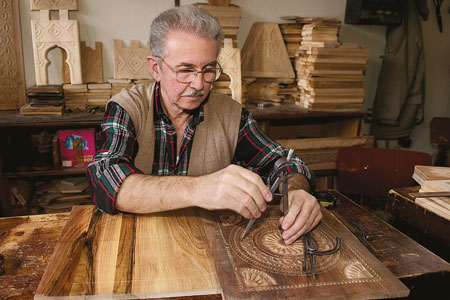
The Art of Bosnia
Issue 91 April 2012
The arts and crafts of Bosnia are a particularly rich and distinctive sector of the country’s living heritage. Fatema Zehra explores this testament to the Bosnian people’s skills and ingenuity.
Metalwork
The Bosnian region is rich in mines, which give local artisans great access to the resources required to distinguish themselves in the production of metal objects. Under Turkish rule, new techniques were used, changing the style of ornaments not only in shape but also in the styles of motifs employed. This Ottoman style of artwork reached its peak between the 17th and 19th centuries when one of three main schools was based in Bosnia. As these techniques were refined, designs became more sophisticated. In the Bašcˇaršija (market), the oldest part of Sarajevo, the street names indicate the crafts that used to be practiced there. The Coppersmiths’ Street exists to this day, perhaps due to the fact that these products can still be purchased locally. The typical coffee sets that adorn every shop window front can be found in every household. On the other hand, the large beautifully detailed jugs are almost exclusively used for decorative purposes. Each craftsman has his own particular style, and in the local area these pieces are immediately recognisable and associated to a particular craftsman. One of these artisans is Sahib Bašcˇauševic´, who comes from a family that has been practicing the craft for well over a century. He once worked with his father and grandfather, and continues the family trade, having lived through the social changes that have led to the shift in use of copper items. They were once utensils that every household required, and have now become decorative objects that serve little other purpose. In spite of this, the knowledge and techniques he has established still remain. This is a frequent story in Bosnia with many of the craftsmen that continue the trade. Whilst the tradition of copper containers in Sarajevo exists to a lesser extent than before, it has almost died out entirely in Mostar, instead being replaced with decorative items that depict the famous Old Bridge of Mostar. The beautiful transformations of metal bear testament to the great works of these craftsmen in continuing this long standing tradition with such remarkable ability.
Woodwork

The landscape of Bosnia is scattered with an abundance of woods and forests, which lends itself well to the use of wood in the tapestry of Bosnian crafts. Wood was widely used in every day to day object from kitchen utensils to home furnishings.
The decorative art of wood naturally came to be expressed through its many uses, for example, wooden musical instruments and furniture, which can be found heavily decorated in simple geometric patterns that eventually shifted to a more refined arabesque style. The art of carved furniture stems from Konjic, a place that by the end of the 19th century was well established for its precious wooden furniture decorated with the geometrical patterns akin to the local tradition, arabesque designs of the Islamic tradition or according to the particular taste of the craftsman. The tradition was widely found throughout the region, with over 17 workshops before World War II, but this has now diminished, with only two families standing out for several generations, the Mulic´s and the Niksic´s. Before the war, Mulic´’s maternal grandfather had a firm that employed 300 people. Both families now enjoy healthy competition with each other, both aware of the value and beauty of their work.
Bookmark this |
|
Add to DIGG |
|
Add to del.icio.us |
|
Stumble this |
|
Share on Facebook |
|
Share this |
|
Send to a Friend |
|
Link to this |
|
Printer Friendly |
|
Print in plain text |
|


Comments
0 Comments